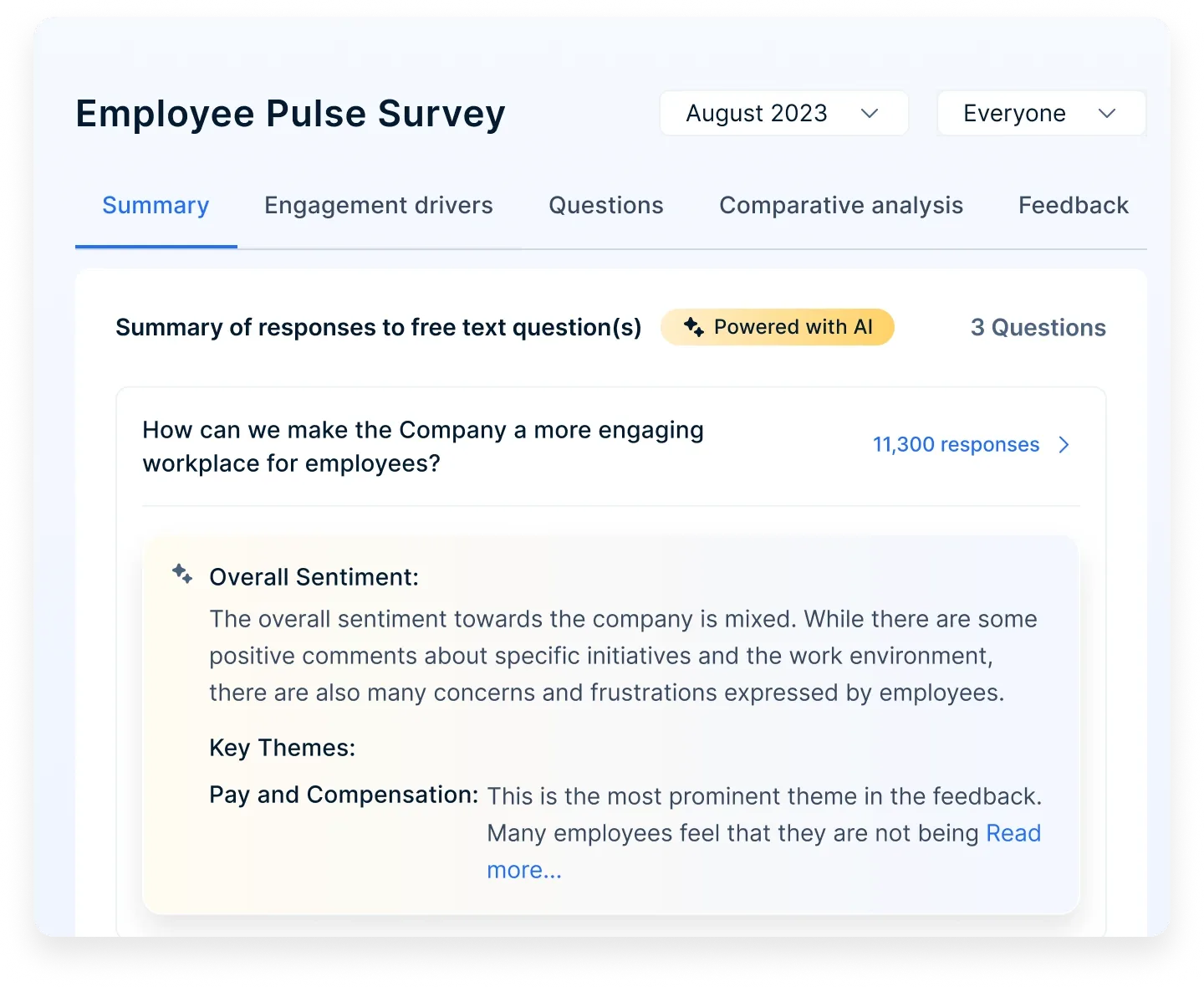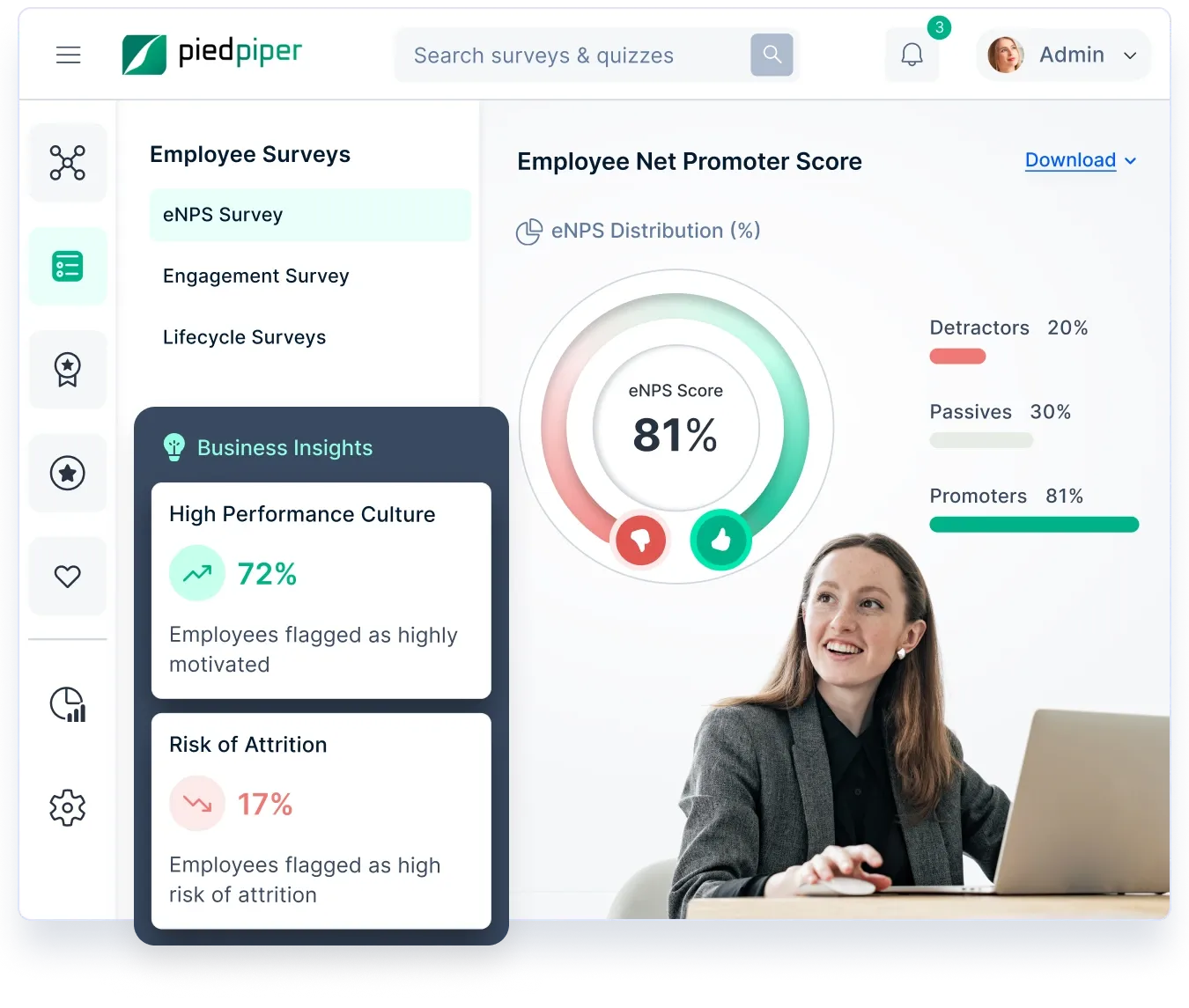استبيانات رضا الموظفين: كيفية قياس وتحسين السعادة في مكان العمل
يساعد استبيان رضا الموظفين المنظم بشكل جيد على قياس مدى سعادة الموظفين في مكان العمل، وتحديد المخاوف، ودفع عجلة التحسينات. يغطي هذا الدليل كل شيء بدءاً من صياغة الأسئلة إلى تحليل الملاحظات للحصول على قوة عاملة أكثر تفاعلاً.
في هذه الصفحة
- ما هو استبيان رضا الموظفين؟
- ما أهمية استبيان رضا الموظفين؟
- لماذا تحتاج الشركات إلى إجراء مسح لرضا الموظفين؟
- العوامل التي تساهم في رضا الموظفين
- كيفية قياس رضا الموظفين
- كيفية إجراء استبيان رضا الموظفين الذي يقدم رؤى قابلة للتنفيذ
- عينة من أسئلة استبيان رضا الموظفين
- 30 أسئلة استبيان رضا الموظفين الإضافية التي يجب عليك تضمينها
- كيف تحافظ على رضا الموظفين في العمل؟
- Empuls الطريقة الذكية لإجراء استبيانات رضا الموظفين
- الخاتمة
- الأسئلة الشائعة
هل يستمتع موظفوك بعملهم بصدق، أم أنك تفترض أنهم راضون عن عملهم؟ تتغاضى العديد من المؤسسات عن أهمية جمع آراء الموظفين الحقيقية، مما يؤدي إلى تفويت فرص التحسين. فبدون إجراء استبيانات منظمة لرضا الموظفين، تخاطر الشركات بانخفاض مستوى المشاركة وارتفاع معدل دوران الموظفين وانخفاض الإنتاجية.
يساعد استبيان الرضا الوظيفي للموظفين المصمم بشكل جيد في الكشف عن الأمور الناجحة والأشياء التي تحتاج إلى تحسين وكيف يشعر الموظفون حقًا تجاه أدوارهم وقيادتهم وثقافة مكان العمل. يسمح فهم هذه الرؤى للمؤسسات بتعزيز الاحتفاظ بالموظفين وزيادة المشاركة وخلق قوة عاملة أكثر تحفيزًا.
ولكن كيف تُجري استبياناً لرضا الموظفين يحقق نتائج مجدية؟ سيرشدك هذا الدليل إلى كل شيء - بدءاً من تصميم الأسئلة الصحيحة إلى تحليل الإجابات واتخاذ خطوات قابلة للتنفيذ نحو بناء مكان عمل أكثر سعادة وتفاعلاً.
ما هو استبيان رضا الموظفين؟
تم تصميم استطلاعات رضا الموظفين لتحديد مدى سعادة أو عدم سعادة موظفيك في شركتك وفي وظائفهم.
إن سؤال الموظفين بشكل مباشر ومنتظم عن التعليقات هو أفضل طريقة للحصول على هذه المعلومات - إذا لم تسأل ، فلن يخبروك. تهدف عملية استطلاعات رضا الموظفين إلى إصلاح هذه الفجوة.
ترسل استطلاعا مجهولا إلى جميع موظفيك بانتظام - يمكن أن يكون كل شهر أو كل ثلاثة أشهر أو كل عام - وتسألهم عما يسير على ما يرام وما الذي يمكن تحسينه.
هناك العديد من الطرق المختلفة لإعداد استبيان رضا الموظفين. تقوم بعض المؤسسات بإجراء استبيانات متكررة وقصيرة قصيرة متكررة لقياس الآراء على مدار العام.
يقوم العديد من أصحاب العمل بإجراء مسح كبير وشامل مرة واحدة في السنة. يجمع البعض بين هاتين الطريقتين. يتعلق الأمر حقا بما يعمل بشكل أفضل لشركتك وموظفيك.
ما أهمية استبيان رضا الموظفين؟
من السهل على القادة والمديرين أن يفترضوا أن الموظفين راضون. ففي النهاية، أنت تقدم لهم وظيفة جيدة وأجر ومزايا لائقة. يبدو أن ذلك يجب أن يكون كافياً.
ولكن من الصعب على الأشخاص رفيعي المستوى معرفة ما يحبه معظم الموظفين وما لا يعجبهم في وظائفهم. قد يكون هناك العديد من العوامل التي لا تعرفها والتي تساهم في عدم رضاهم أو الأشياء التي تعتقد أنها عوامل ثانوية تسبب سعادة الموظفين الكبيرة.
التخمين أو الافتراض لن يحصل لك على هذه الإجابات. لكن استبيان الموظفين المصمم بشكل جيد سوف. والسؤال عن رضا الموظفين ليس مجرد تمرين للشعور الجيد.
وجود موظفين سعداء ومشاركين له فوائد هائلة لعملك.
💡وفقًا لبحث من جامعة وارويك، من المرجح أن يكون الموظفون السعداء أكثر إنتاجية وتفاعلًا - 12% أكثر إنتاجية.
يمكن أن يكون هذا هو الفرق بين الحصول على عام من نتائج الأعمال المنتظمة وتجاوز جميع التوقعات.
لماذا تحتاج الشركات إلى إجراء مسح لرضا الموظفين؟
قد تتبادر إلى ذهنك فكرة "لماذا نقوم باستبيان رضا الموظفين" في نهاية المطاف. لذا إليك بعض الفوائد المهمة التي استبيانات مشاركة الموظفين التي تجلبها للمؤسسة.
1. يعزز مشاركة الموظفين
من السهل أن تتعثر في شبق في العمل وتصل إلى الفضاء حيث يشعر الموظفون وكأنهم على الطيار الآلي. في هذه الحالة ، من السهل التغاضي عن مدى تفاعلهم. ومع ذلك ، يجب ألا تدع هذا يحدث.
الموظفون المتفاعلون سيبذلون جهداً إضافياً للوصول إلى أهداف دورهم. لذا، عليك أن تتأكد من أنهم متفاعلون.
يسمح إجراء استطلاعات رضا الموظفين بانتظام للشركات بالحصول على رؤى وآراء موظفيها حول مكان العمل. من خلال إجراء تحسينات نشطة ، فإنك تظهر لموظفيك أنك تقدر وتقدر ملاحظاتهم.
إن مجرد إجراء استطلاعات الرأي وأخذ أفكار وآراء موظفيك في الاعتبار يمكن أن يفعل المعجزات للحفاظ على تفاعلهم. وسيساعد ذلك على جعلهم يشعرون بالتقدير والتقدير للحصول على نظرة أكثر إيجابية تجاه الشركة. إن زيادة مستوى مشاركة الموظفين يمكن أن يزيد من إنتاجيتهم إنتاجيتهم بنسبة 20%!
2. يسمح لفهم أفضل
هل فكرت في شعور الموظفين؟
ما هي مواقفهم (الإيجابية والسلبية على حد سواء)؟
كيف يشعرون حيال أي تغييرات حدثت؟
هل يتفقون معهم أم يختلفون معهم؟
يمكن لاستطلاعات رضا الموظفين المنتظمة تتبع وتقييم هذه المشاعر والمشاعر بمرور الوقت. وبهذه الطريقة، يمكن للإدارة قياس كيفية تلبية احتياجات الموظفين.
3. نظرة ثاقبة على نمو المنظمات
تسمح الدراسات الاستقصائية بطريقة أفضل لتحديد مسار النمو التنظيمي. على سبيل المثال ، فإنها تمنح الشركات فرصة لتقييم جوانب مثل:
- ➡ تزويد الموظفين بالأدوات المناسبة التي يحتاجونها للقيام بعملهم
- ➡ فعالية الهياكل القيادية
- ➡ صحة صحة ثقافة الشركة وأين يمكن تحسينها.
إذا أخذنا الأمر خطوة أبعد من ذلك، فسنحصل على رؤية أفضل لكيفية عمل الأقسام المختلفة والمشاعر المحيطة بهذا القسم المحدد مقارنةً بالأقسام الأخرى.
إذا كانت أجزاء معينة تعمل بشكل جيد ، فكر في كيفية تحقيق أقصى قدر من هذه النقاط الإيجابية في الأقسام الأخرى.
4. يسمح للموظفين بالاستماع إليهم
يتطلب الأمر موظفا قوي الإرادة للتعبير عن شعوره. في بعض الأحيان ، قد لا يكون الصدق الوحشي مع المدير جيدا ، ومن ثم يتعرض الموظف لخطر إساءة الفهم.
يسمح الاستبيان للموظفين بالحصول على منصة يمكنهم من خلالها التعبير عن آرائهم بحرية في مكان آمن. الاستبيانات مجهولة المصدر طريقة ممتازة للحصول على رؤى أعمق وأكثر صدقًا.
وذلك لأن موظفيك يعرفون أنهم لن يواجهوا أي تداعيات لإعطاء آرائهم.
"الإنسان هو نفسه على الأقل عندما يتحدث في شخصه. أعطه قناعا ، وسيخبرك بالحقيقة." - أوسكار وايلد.
5. يتنبأ ويقلل من دوران الموظفين
تعد معدلات دوران الموظفين المرتفعة مصدر قلق للشركات لأن لها تداعياتها الخاصة فيما يتعلق بالوقت والمال المستثمر في الموظفين. توفر الاستطلاعات رؤى قيمة حول كيفية الحد من عدد الموظفين الذين يفكرون في المغادرة.
يتيح لك طرح الأسئلة الصحيحة الحصول على صورة واضحة عن مدى سعادة موظفيك في وظائفهم. كما يمكن أن يسلط الضوء على ما يريده الموظفون ويحتاجون إليه من حيث حياتهم المهنية على المدى الطويل.
العوامل التي تساهم في رضا الموظفين
دعونا نذهب من خلال بعض عوامل رضا الموظفين:
1. الاستقرار المالي والراتب
بالنسبة للموظفين، قد يكون كل ما يتعلق بالرضا الوظيفي يأتي في المرتبة الثانية بعد معرفة أن الشركة التي يعملون بها لن تتوقف عن العمل قريباً. الأمان المالي يزيل الكثير من الضغط عن كاهل المرء.
لذا، فمن المنطقي أن يكون هذا الأمر من أهم العوامل التي تساهم في تحقيق رضا الموظفين. بالنسبة لأولئك الذين يشعرون بعدم الاستقرار في هذا الصدد، يمكن أن يكون استبيان رضا الموظفين منصة يمكن من خلالها معالجة هذه المواضيع غير المريحة.
2. التقدير
إذا كان الموظفون لا يشعرون بالتقدير والتقدير ، فيمكنك التأكد من أن هذا سيؤثر على مخرجات عملهم. ليس هذا فحسب ، بل إن 79٪ من الموظفين الذين تركوا وظائفهم يقولون إن أحد الأسباب الرئيسية كان بسبب عدم التقدير.
لن يشعر جميع الموظفين دائما بالثقة أو الحرية الكافية للتحدث بصراحة عن الشعور بالتقليل من قيمتهم.
قد تكون هناك أوقات يعتقدون فيها أن عملهم الشاق قد مر دون أن يلاحظه أحد. "شكرا" بسيطا يقطع شوطا طويلا في ضمان شعور موظفيك بالتقدير والتقدير.
3. علاقات جيدة مع الزملاء والإدارة
في كثير من الأحيان، يمكن للعلاقات السيئة مع زملاء العمل أو المديرين أن تجعل مواجهة يوم العمل أكثر صعوبة. في كثير من الأحيان، يمكن حل المشاكل التي تواجهها من خلال التواصل الفعال.
ربما حتى بعض أنشطة بناء الفريق أو غداء أسبوعي للفريق قد يساعد؟ يساهم وجود علاقات عمل جيدة في إرضاء الموظفين بعدة طرق.
إنه يجعلهم يشعرون بتحسن حيال الذهاب إلى العمل ، ويعزز الإنتاجية والروح المعنوية ، ويساهم في بيئة عمل أكثر إيجابية.
4. التوازن بين العمل والحياة
من الطبيعي أن يشعر الموظفون بالإرهاق إذا شعروا بأن عبء عملهم مفرط وأنهم يعملون لساعات طويلة. لا يريد الموظفون أن يصبح عملهم محور تركيز حياتهم.
فهم يرغبون في قضاء الوقت مع عائلاتهم وأصدقائهم وأن يكون لديهم الوقت لممارسة هواياتهم وأشياء أخرى يحبونها. وينطبق هذا بشكل خاص عندما يتعلق الأمر عندما يتعلق الأمر بجيل الألفية.
5. التطوير الوظيفي
كحافز ، يعتبر التعلم والتطوير الوظيفي عاملين مهمين عند النظر إلى رضا الموظفين. يريد الموظفون أن يعرفوا أن الشركة التي يعملون بها لديها اهتمام كبير بالتقدم في حياتهم المهنية.
هل توفر لهم الشركات فرصا لتعلم مهارات جديدة أو البناء على تلك التي يجيدونها ومتحمسون لها؟ وهذا يضيف أيضا إلى مقدار ما يرغب الموظفون في تقديمه إذا شعروا أنهم يستثمرون بانتظام.
كيفية قياس رضا الموظفين
إن قياس رضا الموظفين يتجاوز الافتراضات - فهو يتطلب تغذية راجعة منظمة، وتحليل البيانات، والتحسين المستمر. فيما يلي أكثر الطرق فعالية لتقييم مدى رضا موظفيك حقًا:
1. إجراء دراسات استقصائية لرضا الموظفين
يعد استبيان رضا الموظفين المصمم بشكل جيد أحد أكثر الطرق موثوقية لقياس السعادة في مكان العمل. استخدم مزيجًا من الأسئلة الكمية (مقاييس التصنيف والاختيار من متعدد) والنوعية (أسئلة مفتوحة) للحصول على رؤية شاملة. تتضمن بعض المجالات الرئيسية التي يجب تغطيتها ما يلي:
- الرضا عن الدور الوظيفي
- التوازن بين العمل والحياة
- الدعم الإداري
- فرص النمو الوظيفي
2. استخدام استبيانات الرضا الوظيفي للموظفين في نقاط الاتصال الرئيسية
لا يكفي إجراء استبيان واحد. قم بإجراء استبيانات الرضا الوظيفي للموظف في مراحل مختلفة من دورة حياة الموظف، مثل:
- استبيانات التأهيل - تقييم الانطباعات الأولى للموظفين الجدد.
- استبيانات المشاركة الفصلية أو السنوية - تتبع الاتجاهات طويلة الأجل.
- استطلاعات الخروج - فهم سبب مغادرة الموظفين وكيفية تحسين الاحتفاظ بهم.
3. الاستفادة من استقصاءات النبض للحصول على تغذية راجعة مستمرة
توفر استطلاعات النبض المنتظمة رؤى في الوقت الفعلي حول مشاعر الموظفين. تساعد الاستبيانات القصيرة والمتكررة على تحديد المشكلات الناشئة قبل أن تتفاقم، مما يسهل تنفيذ التحسينات في الوقت المناسب.
4. تحليل eNPS (صافي نقاط المروجين للموظفين)
تقيس eNPS مدى احتمالية توصية الموظفين بالشركة كمكان رائع للعمل. وهو يصنف الإجابات إلى مروجين (9-10)، وسلبيين (7-8)، ومنتقدين (0-6) لتقديم لمحة سريعة عن الرضا العام.
5. رصد مقاييس المشاركة في مكان العمل
تتبع معدلات الاحتفاظ بالموظفين، والتغيب عن العمل، ومستويات الإنتاجية لتحديد اتجاهات الرضا الكامنة. غالبًا ما يشير ارتفاع معدل الدوران والغياب المتكرر إلى عدم المشاركة وعدم الرضا.
6. إجراء مقابلات فردية ومقابلات الإقامة
توفر المحادثات الشخصية مع الموظفين رؤى أعمق حول اهتماماتهم ودوافعهم وتجربتهم الوظيفية بشكل عام. وتساعد مقابلات الإقامة المنتظمة في تحديد ما يحافظ على انخراط الموظفين في العمل وما قد يدفعهم إلى تركه.
7. تشجيع التعليقات المفتوحة من خلال قنوات مجهولة المصدر
قد يتردد الموظفون في مشاركة آرائهم الصريحة بشكل مباشر. ويضمن توفير أدوات التغذية الراجعة المجهولة الهوية شعورهم بالأمان في التعبير عن مخاوفهم، مما يؤدي إلى رؤى أكثر دقة حول مدى رضا الموظفين عن مكان العمل.
إن قياس رضا الموظفين ليس عملية تتم لمرة واحدة - بل يتطلب ملاحظات وتحليلات وإجراءات مستمرة. وباستخدام مزيج من الاستطلاعات ومقاييس المشاركة والمحادثات المباشرة، يمكن للمؤسسات بناء ثقافة مكان العمل التي تقدر رفاهية الموظفين وتعطي الأولوية لها.

قياس رضا الموظفين وتحسينه باستخدام Empuls
استكشف الرؤى الحقيقية للموظفين باستخدام أداة استبيان رضا الموظفين من Empuls. أنشئ استطلاعات رأي قابلة للتخصيص، واجمع ملاحظات صادقة، واتخذ إجراءات قائمة على البيانات لتعزيز السعادة والاحتفاظ بالموظفين في مكان العمل.
كيفية إجراء استبيان رضا الموظفين الذي يقدم رؤى قابلة للتنفيذ
يتجاوز استبيان رضا الموظفين الذي يتم تنفيذه بشكل جيد مجرد جمع الإجابات - بل يجب أن يكشف عن المشاعر الحقيقية في مكان العمل ويقود إلى تحسينات قابلة للقياس. إليك كيفية تنظيم وتنفيذ استبيان يوفر رؤى قيمة بدلاً من مجرد بيانات.
1. تحديد هدف واضح
قبل صياغة الأسئلة، حدد ما تريد قياسه. هل تقوم بتقييم الرضا الوظيفي العام، أو تحديد أسباب دوران الموظفين، أو تقييم فعالية القيادة؟ سيؤدي الاستطلاع بدون تركيز واضح إلى رؤى مبعثرة يصعب التصرف بناءً عليها.
2. استخدام مزيج من أنواع الأسئلة
تجنب الاستبيانات التي تعتمد فقط على مقاييس التصنيف. وبدلاً من ذلك، قم بالموازنة بين الأسئلة الكمية (مقياس ليكرت، والاختيار من متعدد) والأسئلة النوعية (مفتوحة) لالتقاط كل من الاتجاهات والرؤى الأعمق. أمثلة على ذلك:
- على مقياس من 1 إلى 10، ما مدى رضاك عن فرص تطورك الوظيفي؟
- ما هو الشيء الوحيد الذي يمكن أن تفعله الشركة لتحسين تجربتك في العمل؟
3. اجعلها موجزة ولكن شاملة
إن الاستبيان الذي يستغرق أكثر من 10 دقائق لإكماله قد يؤدي إلى انخفاض نسبة المشاركة. استهدف 15-20 سؤالاً مستهدفاً تغطي مجالات رئيسية مثل:
- الرضا الوظيفي ووضوح الدور الوظيفي
- فعالية القيادة والإدارة
- التوازن بين العمل والحياة الشخصية والمرونة
- فرص النمو والتعلم
- التقدير وثقافة مكان العمل
4. ضمان عدم الكشف عن الهوية للحصول على تعليقات صادقة
إذا خشي الموظفون من رد الفعل العنيف، فسوف يقدمون إجابات دبلوماسية بدلاً من تقديم رؤى حقيقية. استخدم أداة استبيان مجهولة الهوية لضمان السرية وتوصيل ذلك بوضوح في تعليمات الاستبيان.
5. اختر التوقيت والتردد المناسبين
- تعمل استبيانات النبض الفصلية بشكل جيد لتتبع اتجاهات المشاركة.
- توفر الدراسات الاستقصائية السنوية المتعمقة رؤى شاملة ولكنها تتطلب إجراءات متابعة قوية.
- ترصد استطلاعات الخروج من الخدمة أسباب مغادرة الموظفين وكيف يمكن تحسين استراتيجيات الاحتفاظ بالموظفين.
6. تعزيز المشاركة من خلال التواصل الشفاف
غالباً ما تنبع معدلات الاستجابة المنخفضة من ضعف التواصل. ولزيادة المشاركة:
- اشرح سبب أهمية الاستطلاع وكيفية استخدام الملاحظات.
- احصل على موافقة القيادة - عندما يشجع المديرون على المشاركة، فمن المرجح أن يشارك الموظفون.
- أرسل رسائل تذكيرية ولكن تجنب المتابعات المفرطة التي تشعرك بالإلحاح.
7. التصرف بناءً على التغذية الراجعة وإغلاق الحلقة
أكبر خطأ ترتكبه الشركات هو جمع البيانات دون التصرف بناءً عليها. بعد تحليل النتائج:
- مشاركة النتائج رفيعة المستوى مع الموظفين - الشفافية تبني الثقة.
- حدد أولويات مجالات العمل الرئيسية بدلاً من محاولة إصلاح كل شيء دفعة واحدة.
- تعيين الملكية لفرق الموارد البشرية أو فرق القيادة لتنفيذ التحسينات.
- المتابعة مع الموظفين لإظهار ما يتم تغييره بناءً على ملاحظاتهم.
8. قياس الأثر بمرور الوقت
لن يحل الاستطلاع لمرة واحدة مشاكل المشاركة. قارن النتائج بمرور الوقت لتقييم ما إذا كانت التغييرات تعمل أم لا. إذا ظلت النتائج راكدة، قم بتنقيح أسئلة الاستبيان أو استكشف استراتيجيات مشاركة إضافية.
عند إجرائه بشكل صحيح، يصبح استبيان رضا الموظفين أداة قوية لصنع القرار تساعد الشركات على الاحتفاظ بالمواهب وتعزيز الروح المعنوية وخلق ثقافة مزدهرة في مكان العمل
عينة من أسئلة استبيان رضا الموظفين
والآن بعد أن عرفت ما هي استطلاعات رضا الموظفين، وسبب أهميتها لنجاح شركتك، وما هي العوامل التي تجعل الموظفين راضين حقًا، يمكنك التفكير في إنشاء استبيان رضا الموظفين الخاص بك.
يمكنك العثور على الكثير من نماذج أسئلة استبيان رضا الموظفين: لدى SHRM نموذج قيّم لإنشاء استبيان خاص بك. نموذج إطار غالوب المكون من 12 سؤالاً شائع أيضاً لدى العديد من الشركات لقياس مدى مشاركة الموظفين ورضاهم.
إذا كنت تبحث عن حل متكامل لإشراك الموظفين، يمكنك العمل مع نظام ينشئ لك استبيانًا مثل Empuls.
هل تبحث عن مزيد من الإرشادات حول أسئلة استطلاع رضا الموظفين الرائعة؟ فيما يلي بعض الاقتراحات للبدء.
1. هل أنت مستوحى من مهمة وغرض شركتنا؟
يستمتع الموظفون بالعمل في مكان ما بقيم قوية ومهمة واضحة ، سواء كان ذلك يعمل بشكل جيد في العالم أو يخدم العملاء بتميز ونزاهة.
إذن، ما هو مستوى أداء شركتك؟
2. هل ترى طريقا للتقدم وتنمية حياتك المهنية معنا؟
حتى إذا كان الموظفون يستمتعون بالعمل في شركتك، فلن يظلوا راضين إذا لم يروا مسارًا للنمو على المدى الطويل في شركتك. ووفقًا لبحث أجرته شركة Deloitte، فإنهم سيغادرون بعد ذلك - فعدم وجود فرص للتطور الوظيفي هو السبب الرئيسي وراء مغادرة موظفيك للعمل في شركة أخرى. لذا، فإن قياس أدائك في هذا المجال له قيمة كبيرة.
3. هل تحب ثقافة شركتنا؟
ربما تكون قد عملت بجد لتشكيل ثقافة واعية وواضحة في مكان عملك - أو ربما لست متأكدا من أين تبدأ.
إن سؤال الموظفين عما إذا كانوا يستمتعون بثقافة مكان عملك أمر جيد للبدء في إنشاء قوة عاملة صحية وسعيدة.
4. هل تجد عملك ذا مغزى؟
نحن جميعًا نريد أن نقوم بعمل لا يقتصر على مجرد التحقق من المربعات في قائمة المهام - بل له معنى حقيقي. سيكون لدى موظفيك جميعًا تعريفات مختلفة لمعنى عملهم، ولكن سؤالهم عما إذا كانوا يشعرون بأن عملهم مهم بطريقة ما هو طريقة جيدة لقياس المشاركة والسعادة.
في الواقع، تعد القدرة على القيام بعمل هادف أمرًا حيويًا للغاية بالنسبة للموظفين لدرجة أن 9 من كل 10 أشخاص استطلع الباحثون آراءهم سيقبلون بتخفيض كبير في الأجور مقابل القيام بعمل أكثر أهمية بالنسبة لهم.
5. كيف تقيم التوازن بين العمل والحياة؟
التوازن بين العمل والحياة الشخصية أمر حيوي للحصول على موظفين سعداء ومنتجين. فالإرهاق الناجم عن عدم الحصول على إجازات كافية أو العمل لساعات طويلة طوال الوقت يؤدي إلى انخفاض مستوى الرضا. 53% من الموظفين أن التوازن بين العمل والحياة الشخصية أمر بالغ الأهمية بالنسبة لهم.
قد يكون لديك سياسة إجازة سخية ، ولكن إلى أي مدى تشجع ثقافة شركتك وإدارتها على أخذ هذه الإجازة؟
6. هل تمنحك شركتنا الأدوات والتكنولوجيا اللازمة للقيام بعملك بشكل جيد؟
إذا كان لديك موظفون يحبون وظائفهم ورائعون فيها ولكنهم لا تعطيهم الأدوات الأساسية التي يحتاجونها للقيام بهذه الوظائف ، فسوف يشعرون بالإحباط والتعاسة. يمكن أن يكون هذا نقصا في البرامج الحديثة أو أجهزة الكمبيوتر أو العناصر الأخرى التي يحتاجونها لإنجاز مهامهم.
7. ما مدى سعادتك في العمل؟
إذا كنت تريد معرفة ما إذا كان موظفوك سعداء في العمل ، فاسألهم عما إذا كانوا سعداء! من السهل ولكن الفعال أن تسأل مباشرة عن مستويات رضاهم.
8. هل تشعر بالتقدير لمساهماتك؟
إن تقدير وتقدير تبدو مساهمات موظفيك في شركتك كل يوم أمراً أساسياً للغاية - ولكن الكثير من القادة والمديرين يفشلون في إعطاء الأولوية لذلك.
استخدم هذا السؤال للتحقق من كيفية تعامل ثقافتك مع تقدير الموظفين وما إذا كان الموظفون يشعرون بأن عملهم يحظى بالتقدير. إذا لم يكن الأمر كذلك، فلديك عمل عليك القيام به.

احصل على قوالب استبيان رضا الموظفين الجاهزة للاستخدام
وفّر الوقت واجمع ملاحظات مفيدة مع قوالب الاستبيانات المصممة من قِبل الخبراء من Empuls. اختر من بين القوالب القابلة للتخصيص لقياس رضا الموظفين ومشاركتهم وثقافة مكان العمل دون عناء.
30 أسئلة استبيان رضا الموظفين الإضافية التي يجب عليك تضمينها
يجب أن يغطي استبيان جيد التنظيم لرضا الموظفين جوانب متعددة من تجربة مكان العمل. فيما يلي 30 سؤالاً مصنفة بعناية لضمان فهم شامل لمشاعر الموظفين.
أسئلة استبيان الرضا الوظيفي ووضوح الأدوار للموظفين
إن فهم شعور الموظفين تجاه أدوارهم ومسؤولياتهم أمر بالغ الأهمية للحفاظ على المشاركة والإنتاجية. وتقيّم هذه الأسئلة ما إذا كان الموظفون يجدون عملهم مُرضيًا ومتماشيًا مع مهاراتهم ومحددًا بوضوح.
- ما مدى رضاك عن دورك ومسؤولياتك الحالية؟
- هل لديك فهم واضح لتوقعاتك وأهدافك الوظيفية؟
- هل تشعر أن عملك يساهم بشكل هادف في نجاح الشركة؟
- هل أنت متحمس لمهامك ومشاريعك اليومية؟
أسئلة استبيان الموظفين حول ثقافة وبيئة العمل
تعزز الثقافة الإيجابية في مكان العمل التعاون والثقة والشمولية. تساعد هذه الأسئلة في تحديد ما إذا كان الموظفون يشعرون بالتقدير والدعم والراحة في بيئة عملهم.
- كيف تصف ثقافة العمل بشكل عام في المؤسسة؟
- هل تشعر بأنك مشمول ومحترم كجزء من فريقك؟
- ما مدى ارتياحك لمشاركة الأفكار والاهتمامات في العمل؟
- هل تعزز الشركة التوازن القوي بين العمل والحياة الشخصية؟
أسئلة استبيان الموظفين حول القيادة والإدارة
تلعب القيادة الفعالة دورًا هامًا في مشاركة الموظفين ورضاهم. تقيّم هذه الأسئلة مدى دعم المدراء والقادة لفرقهم وتواصلهم وتوجيههم لفرقهم.
- ما مدى فعالية مديرك في تقديم الملاحظات والتوجيهات؟
- هل تشعر بالراحة في التواصل مع مديرك بشأن مخاوفك؟
- هل تعتقد أن القيادة تتسم بالشفافية بشأن أهداف الشركة وقراراتها؟
- كم مرة تتلقى التقدير والتقدير من مديرك؟
أسئلة استبيان الموظفين حول التعويضات والمزايا
تؤثر الأجور والمزايا العادلة بشكل مباشر على تحفيز الموظفين والاحتفاظ بهم. تُقيّم هذه الأسئلة ما إذا كان الموظفون يشعرون بأنهم يحصلون على تعويضات ومزايا كافية ومدعومة بالامتيازات والحوافز.
- هل تعتقد أن راتبك يعكس مساهماتك ومسؤولياتك بشكل عادل؟
- هل أنت راضٍ عن المزايا التي تقدمها الشركة (الرعاية الصحية، والمكافآت، والإجازات مدفوعة الأجر، وما إلى ذلك)؟
- كيف تقيم برامج المكافآت والتقدير في الشركة؟
- هل تشعر أن الشركة تقدم لك حوافز مالية تتماشى مع أدائك؟
أسئلة استبيان الموظفين حول النمو والتطور الوظيفي
يريد الموظفون أن يشعروا بأن لديهم مجالاً للتطور داخل المؤسسة. تستكشف هذه الأسئلة ما إذا كان الموظفون يشعرون بالدعم في تطورهم المهني وتقدمهم الوظيفي.
- هل لديك فرص للتعلم والتقدم الوظيفي؟
- هل تشعر أن الشركة تستثمر في تطورك المهني؟
- هل هناك مسارات واضحة للتقدم الوظيفي داخل الشركة؟
- كم مرة تتلقى ملاحظات بناءة تساعدك على التحسن؟
أسئلة استبيان الموظفين حول عبء العمل والإنتاجية
تؤثر إدارة عبء العمل بشكل مباشر على مستويات إجهاد الموظفين ومشاركتهم. تقيّم هذه الأسئلة ما إذا كان الموظفون يشعرون بالدعم في الحفاظ على سير عمل متوازن ومنتج.
- هل تشعر أن عبء العمل لديك معقول ويمكن التحكم فيه؟
- كم مرة تعاني من الإجهاد أو الإرهاق بسبب العمل؟
- هل تم تزويدك بالأدوات والموارد اللازمة لأداء عملك بكفاءة؟
- هل يتعاون فريقك بفعالية لتحقيق الأهداف المشتركة؟
أسئلة استبيان مشاركة الموظفين وتحفيزهم
يمكن أن يساعد فهم ما يحفز الموظفين الشركات على بناء قوة عاملة عالية الأداء. تعمل هذه الأسئلة على تقييم مستويات المشاركة والعوامل التي تدفع الحماس في مكان العمل.
- هل تشعر بالحافز لبذل قصارى جهدك كل يوم؟
- هل تعزز الشركة بيئة تشجع على الابتكار والإبداع؟
- هل تشعر بالتقدير لمساهماتك؟
- ما مدى رضاك عن مستوى الاستقلالية في دورك؟
أسئلة استطلاع رأي الموظفين حول التواصل والشفافية في الشركة
التواصل الواضح يبني الثقة ويعزز التزام الموظفين. تقيس هذه الأسئلة مدى فهم الموظفين لأهداف الشركة وشعورهم بالاطلاع على قرارات الشركة.
- هل تشعر بأنك على علم بتحديثات الشركة والتغييرات الاستراتيجية؟
- ما مدى شفافية القيادة عند التواصل مع قرارات الشركة المهمة؟
يجب أن يتناول استبيان جيد التنظيم لرضا الموظفين العوامل الرئيسية التي تؤثر على السعادة في مكان العمل، بما في ذلك وضوح الأدوار والثقافة والقيادة والتعويضات وفرص النمو. ويساعد جمع الملاحظات بانتظام الشركات على إجراء تحسينات قائمة على البيانات وتعزيز تجربة الموظفين بشكل عام.
كيف تحافظ على رضا الموظفين في العمل؟
هذه مجرد نماذج قليلة من الأسئلة التي يمكنك تضمينها في استبيان رضا الموظفين. من الأفضل إعطاء الأولوية لطرح الأسئلة التي ترتبط بأهداف العمل أو المجالات التي تحاول تحسينها.
ما هي المجالات المهمة التي يجب التركيز عليها؟
فيما يلي الفئات الرئيسية التي تساهم في رضا الموظفين:
1. الثقافة
ثقافة مكان عملك أمر حيوي لسعادة الموظفين. هل خلقت بيئة مليئة بالقدرة التنافسية والإجهاد والإرهاق؟ أم أنك في طريقك إلى ثقافة يشعر فيها الموظفون بالأمان والتقدير والتحدي للنمو؟
قد يكون لثقافة مكان عملك مهمة إرشادية واضحة أو قد تكون مكونة من معايير غير معلنة. ولكنك بالتأكيد لديك واحدة - لذا اعمل على أن تكون إيجابية.
2. زملاء العمل
هل لديك صديق مقرب في العمل؟ قد يكون لدى موظفيك - وهذا شيء رائع. فهو يؤدي إلى ضعف مستوى المشاركة إذا كان لديك. إذا فكرت في الأمر، فإننا نقضي وقتًا مع زملائنا في العمل أكثر من معظم الأشخاص الآخرين في حياتنا.
لذا، من المنطقي أن وجود زملاء عمل تثق بهم وتحبهم وتحترمهم أمر بالغ الأهمية لسعادة الموظفين. هل تقوم بتوظيف أشخاص يخلقون هذه البيئة الإيجابية؟
3. العلاقة مع المدير
يؤثر المديرون بشكل كبير على الأجزاء الحيوية في تجربة الموظف، أي نوع العمل الذي يقوم به الموظفون، ومسارهم الوظيفي، وتجربتهم اليومية في العمل.
4. الاستقلالية
عندما تقوم بتوظيف أفضل الموظفين، فأنت تريد أن تثق بهم لأداء وظائفهم بشكل جيد. الإدارة التفصيلية محبطة للموظفينخاصةً بالنسبة لأفضل الموظفين الذين يؤدون وظائفهم بشكل جيد.
هل تسمح للموظفين بالاستقلالية والملكية على عملهم؟ وهذا يؤدي إلى مزيد من الرضا والسعادة.
Empuls الطريقة الذكية لإجراء استبيانات رضا الموظفين

إن فهم مشاعر الموظفين هو المفتاح لتعزيز ثقافة العمل الإيجابية. أداة Empulsأداة استطلاع رضا الموظفين من إمبلس سهولة جمع آراء الموظفين وتحليلها والتصرف بناءً عليها، مما يضمن بقاء المؤسسات على اتصال دائم بالقوى العاملة لديها.
لماذا نستخدم Empuls لاستطلاعات رضا الموظفين؟
- قوالب جاهزة للاستخدام واستطلاعات مخصصة - اختر من بين القوالب المصممة من قِبل الخبراء أو أنشئ استبياناتك الخاصة لطرح الأسئلة المناسبة.
- استبيانات النبض ودورة الحياة المؤتمتة - احصل على ملاحظات في الوقت الفعلي في مراحل رحلة الموظف المختلفة، بدءاً من مرحلة الإعداد وحتى الخروج.
- رؤى تستند إلى الذكاء الاصطناعي لاتخاذ قرارات أكثر ذكاءً - تحديد اتجاهات المشاركة الرئيسية، والكشف عن عوامل فك الارتباط الخفية، واتخاذ إجراءات بناءً على البيانات.
- جمع الملاحظات ومشاركتها بسلاسة - يمكنك توزيع الاستبيانات بسهولة من خلال Slack أو Microsoft Teams أو البريد الإلكتروني، مما يجعل المشاركة سهلة.
- إجابات سرية وخالية من التحيز - شجع على تقديم تعليقات صادقة من خلال خيارات الاستبيان مجهولة المصدر التي تبني الثقة والشفافية.
باستخدام Empuls يمكن للمؤسسات أن تتجاوز مجرد قياس الرضا، حيث يمكنها التعرف على الإنجازات وتعزيز المشاركة وخلق مكان عمل مزدهر.
الخاتمة
إن استبيان رضا الموظفين المنظم جيدًا هو أكثر من مجرد أداة للتغذية الراجعة - إنه نهج استراتيجي لتحسين ثقافة مكان العمل، وتعزيز المشاركة، والاحتفاظ بأفضل المواهب. إن فهم كيفية إجراء استبيان رضا الموظفين يضمن للمؤسسات جمع رؤى دقيقة وقابلة للتنفيذ تؤدي إلى تحسينات ذات مغزى.
من خلال تصميم استبيان الرضا الوظيفي المناسب للموظفين وتعزيز بيئة يشعر فيها الموظفون بأن صوتهم مسموع، يمكن للشركات تحديد الدوافع الرئيسية للمشاركة، ومعالجة المخاوف المتعلقة بمكان العمل، وتعزيز الإنتاجية الإجمالية.
ومع ذلك، فإن جمع الملاحظات ليس سوى الخطوة الأولى - فالتصرف بناءً على نتائج الاستبيان هو ما يعزز الثقة والتحفيز والالتزام على المدى الطويل.
عندما تعطي المؤسسات الأولوية لرضا الموظفين، فإنها تخلق ثقافة يكون فيها الموظفون أكثر انخراطاً وإنتاجية واستثماراً في نجاح الأعمال.
الأسئلة الشائعة
1. ما هو الغرض من استبيان رضا الموظفين؟
تم تصميم استبيان رضا الموظفين لتقييم مدى شعور الموظفين بالرضا والرضا في أدوارهم وداخل المؤسسة. الغرض الأساسي هو جمع رؤى قابلة للتنفيذ تساعد على تحسين ثقافة مكان العمل والمشاركة والاحتفاظ بالموظفين.
من خلال قياس مستويات الرضا في مجالات مثل المسؤوليات الوظيفية والقيادة والتعويضات والنمو الوظيفي وبيئة العمل، يمكن للشركات تحديد نقاط الضعف ومعالجة المخاوف ووضع استراتيجيات تعزز تجربة الموظفين. عند إجراء هذه الاستطلاعات بانتظام، تساعد هذه الاستطلاعات المؤسسات على تعزيز الروح المعنوية وتقليل معدل دوران الموظفين وتحقيق نجاح الأعمال على المدى الطويل.
2. كم مرة ينبغي إجراء استقصاءات رضا الموظفين؟
يعتمد التكرار على احتياجات الشركة. توفر الاستطلاعات السنوية رؤى عميقة، في حين أن الاستطلاعات الفصلية أو الاستطلاعات النبضية تتبع اتجاهات المشاركة في الوقت الفعلي. تضمن المتابعة المنتظمة التحسين المستمر.
3. ما هي العناصر الرئيسية لاستطلاع جيد لرضا الموظفين؟
يجب أن يتضمن الاستبيان المصمم جيدًا أسئلة واضحة وغير متحيزة، ومزيجًا من الإجابات الكمية والنوعية، وعدم الكشف عن الهوية للحصول على تعليقات صادقة، والمتابعة القابلة للتنفيذ بناءً على النتائج.
4. ما الفرق بين استبيان رضا الموظفين واستبيان المشاركة؟
تقيس استبيانات الرضا السعادة في مكان العمل والتعويضات وظروف العمل، بينما تقيس استبيانات المشاركة التحفيز والالتزام والارتباط العاطفي بالمؤسسة.
5. كيف يمكن للشركات أن تتصرف بناء على نتائج استبيان رضا الموظفين؟
يجب على المؤسسات تحليل الاتجاهات، وتحديد القضايا الحرجة، وتوصيل النتائج بشفافية، وتنفيذ استراتيجيات لمعالجة مخاوف الموظفين. تؤدي حلقات التغذية الراجعة المستمرة إلى تحسينات حقيقية.
6. ما هي الأخطاء الشائعة التي يجب على الشركات تجنبها في استبيانات الرضا؟
تجنب الاستطلاعات المطولة، والأسئلة الغامضة أو الموجهة، وعدم الكشف عن الهوية، وعدم التصرف بناءً على الملاحظات. يمكن أن يؤدي سوء تنفيذ الاستبيان إلى عدم المشاركة وعدم الثقة في العملية.













